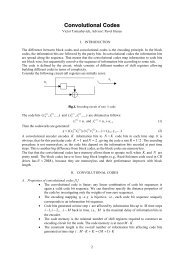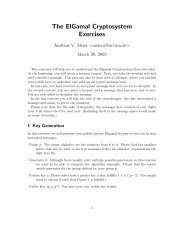Benakeion Archaeological Museum of Kalamata
Benakeion Archaeological Museum of Kalamata
Benakeion Archaeological Museum of Kalamata
- No tags were found...
You also want an ePaper? Increase the reach of your titles
YUMPU automatically turns print PDFs into web optimized ePapers that Google loves.
<strong>Benakeion</strong> <strong>Archaeological</strong> <strong>Museum</strong> <strong>of</strong> <strong>Kalamata</strong><br />
<strong>Benakeion</strong> <strong>Archaeological</strong> <strong>Museum</strong> <strong>of</strong><br />
<strong>Kalamata</strong><br />
The <strong>Benakeion</strong> <strong>Archaeological</strong> <strong>Museum</strong><br />
is situated at the heart <strong>of</strong> the historical<br />
centre <strong>of</strong> <strong>Kalamata</strong>. This remarkable<br />
Venetian-style mansion, at the corner <strong>of</strong><br />
Benaki and Papazoglou streets,<br />
accommodates a rich collection <strong>of</strong><br />
archaeological treasures from various sites<br />
in Messenia, which span the time from the<br />
Bronze Age to the Roman period. The<br />
museum owes its name to Antonios<br />
Benakis, founder <strong>of</strong> the Benaki <strong>Museum</strong> in<br />
Athens. Following his wish, the building<br />
was donated to the Greek <strong>Archaeological</strong><br />
Service by his heirs in 1962. Built in 1742,<br />
during the Turkish occupation, it was<br />
closely associated with important historical events <strong>of</strong> that period. In 1971 it was opened as a museum.<br />
The old exhibition included finds from small-scale excavations undertaken by the 7th Ephorate <strong>of</strong><br />
Prehistoric and Classical Antiquities, but its nucleus was formed by artefacts from the major excavations<br />
at Malthi and Nichoria. The mezzanine floor housed Byzantine antiquities and other historical relics from<br />
<strong>Kalamata</strong>.<br />
On 14 September 1986, a destructive earthquake struck <strong>Kalamata</strong>. The museum and most <strong>of</strong> its exhibits<br />
were seriously damaged. The archaeologists, conservators and workmen <strong>of</strong> the 7th Ephorate mounted a<br />
titanic effort to pack and transport the exhibits to the Olympia <strong>Museum</strong> for safekeeping and conservation.<br />
The restoration <strong>of</strong> the building lasted five years (1988-1992) and was coupled with a redisplay project,<br />
which resulted in the inauguration <strong>of</strong> the exhibition on the ground floor in 1995. Three years later the<br />
http://www.culture.gr/2/21/211/21107m/e211gm01.html (1 <strong>of</strong> 5) [1/24/2005 2:30:27 PM]
<strong>Benakeion</strong> <strong>Archaeological</strong> <strong>Museum</strong> <strong>of</strong> <strong>Kalamata</strong><br />
second floor was completed. The new display, inaugurated in 2000, aims at allowing visitors to approach<br />
the artefacts through comprehensive thematic units, while conveying information about their use and<br />
significance. By using ample visual material (maps, photographs, models, reconstructions) visitors gain a<br />
better understanding <strong>of</strong> various aspects <strong>of</strong> the civilization that flourished in Messenia for centuries.<br />
Ground Floor<br />
The ground floor exhibition occupies four rooms with finds from various sites in Messenia, dating from<br />
Classical to Roman times.<br />
The first room is dedicated to sculptures<br />
mainly from Petalidi (ancient Koroni).<br />
Among them, the inscribed Herm stele<br />
with inserted head <strong>of</strong> a youth from ancient<br />
Messene is <strong>of</strong> prime importance. The<br />
following room is devoted to burial<br />
customs. Inscribed grave stelae, relief<br />
plaques representing funerary feasts (nekrodeipna), and part <strong>of</strong> a<br />
sarcophagus are on display.<br />
The third room houses architectural<br />
members and inscriptions from various<br />
sites in Messenia. A decree stele from<br />
ancient Thouria is <strong>of</strong> particular interest.<br />
The fourth room contains a fine mosaic<br />
from Koroni, and fragments <strong>of</strong> another<br />
Roman mosaic from Dessila.<br />
http://www.culture.gr/2/21/211/21107m/e211gm01.html (2 <strong>of</strong> 5) [1/24/2005 2:30:27 PM]
<strong>Benakeion</strong> <strong>Archaeological</strong> <strong>Museum</strong> <strong>of</strong> <strong>Kalamata</strong><br />
Second Floor<br />
The first room (showcases 1-4) is largely<br />
devoted to the rich mycenaean tholos tomb<br />
at Nichoria, which contained pottery,<br />
bronze objects, seals and jewellery made <strong>of</strong><br />
gold and semi-precious stones.<br />
The second room houses representative finds<br />
from the settlement at Nichoria (showcase 7),<br />
whose inhabitation spans the time from the<br />
Middle Helladic period until the Byzantine era.<br />
The American School <strong>of</strong> Classical Studies in<br />
Athens, under Pr<strong>of</strong>essor W.A. McDonald,<br />
embarked on a pioneering project (1969-1973)<br />
which involved scientists from all related fields<br />
in order to provide a comprehensive overview <strong>of</strong> all aspects <strong>of</strong> daily life in this<br />
ancient community. In the same room, the most important grave <strong>of</strong>ferings from<br />
the cemeteries at Nichoria-Karpophora are on view, dating from early Mycenaean to Early Geometric<br />
and Classical times (showcases 9-10).<br />
The third room accommodates objects<br />
from the acropolis <strong>of</strong> Malthi, which<br />
flourished during the Middle Helladic and<br />
Mycenaean periods. Pottery (showcase<br />
11), tools and ornaments made <strong>of</strong> stone<br />
and bone (showcases 12, 14) give valuable<br />
information about the everyday life <strong>of</strong> Malthi's prehistoric dwellers.<br />
Prominently displayed is the Neolithic-type figurine <strong>of</strong> a seated female<br />
figure (showcase 13), one <strong>of</strong> the most important finds <strong>of</strong> the excavation, which was conducted by the<br />
Swedish archaeologist M.N. Valmin between 1926-1936. The same room is also dedicated to the Early<br />
Helladic "megaron" unearthed at Akovitika, with sherds and a clay sealing typical <strong>of</strong> that period on view<br />
(showcase 15).<br />
http://www.culture.gr/2/21/211/21107m/e211gm01.html (3 <strong>of</strong> 5) [1/24/2005 2:30:27 PM]
<strong>Benakeion</strong> <strong>Archaeological</strong> <strong>Museum</strong> <strong>of</strong> <strong>Kalamata</strong><br />
The fourth room contains finds from recent<br />
excavations carried out by the 7th Ephorate<br />
<strong>of</strong> Antiquities at various sites in Messenia<br />
(showcase 16), mainly from the<br />
mycenaean necropolis at Antheia-<br />
Hellenika (showcases 17-18), which<br />
yielded remarkable gold jewellery. Also on<br />
display are objects from the Archaic house at Kopanaki (showcase 19)<br />
and the temple <strong>of</strong> the river god Pamisos discovered at Agios Floros<br />
(showcase 21). Finally, the exhibition includes chance finds handed over to the Greek <strong>Archaeological</strong><br />
Service (showcase 20).<br />
Address<br />
Prefecture<br />
Region<br />
Ephorate<br />
Opening hours<br />
Tickets<br />
6 Papazoglou Str., 241 00 <strong>Kalamata</strong><br />
Messenia<br />
Peloponnesos<br />
7th Ephorate <strong>of</strong> Prehistoric and Classical Antiquities<br />
Winter Opening Hours<br />
Telephone +30-27210-26.209<br />
Tickets<br />
[Information]<br />
[Home_Page]<br />
[Mail]<br />
[Search]<br />
[Show_Frames]<br />
[The_Identity_<strong>of</strong>_the_Ministry]<br />
[<strong>Museum</strong>s_and_<strong>Archaeological</strong>_Sites]<br />
[Modern_and_Contemporary_Cultural_Creation]<br />
[Cultural_Organizations]<br />
[Cultural_Events]<br />
[Selected_Cultural_Events]<br />
[Special_Issues]<br />
[Announcements-Press_Releases]<br />
[Guide_to_the_Internet]<br />
http://www.culture.gr/2/21/211/21107m/e211gm01.html (4 <strong>of</strong> 5) [1/24/2005 2:30:27 PM]
<strong>Benakeion</strong> <strong>Archaeological</strong> <strong>Museum</strong> <strong>of</strong> <strong>Kalamata</strong><br />
©1995-2001 Hellenic Ministry <strong>of</strong><br />
Culture<br />
http://www.culture.gr/2/21/211/21107m/e211gm01.html (5 <strong>of</strong> 5) [1/24/2005 2:30:27 PM]



![The ElGamal Cryptosystem[PDF]](https://img.yumpu.com/50668335/1/190x245/the-elgamal-cryptosystempdf.jpg?quality=85)
![Course ''Proofs and Computers``, JASS'06 [5mm] PCP-Theorem by ...](https://img.yumpu.com/33739124/1/190x143/course-proofs-and-computers-jass06-5mm-pcp-theorem-by-.jpg?quality=85)

![Introduction to Complexity Theory [PDF]](https://img.yumpu.com/32815560/1/184x260/introduction-to-complexity-theory-pdf.jpg?quality=85)



![Toda's Theorem II [PDF]](https://img.yumpu.com/10692943/1/190x143/todas-theorem-ii-pdf.jpg?quality=85)